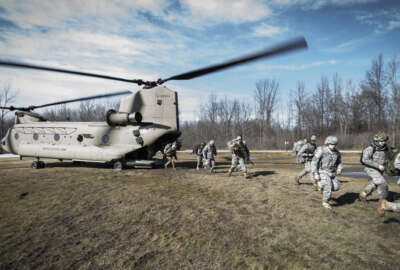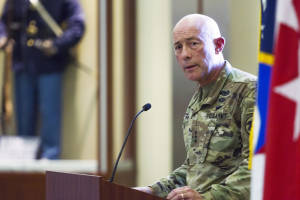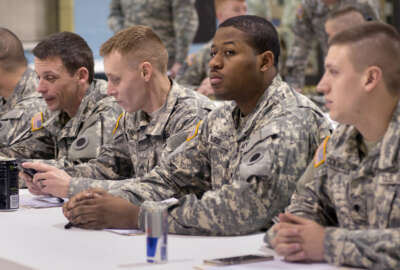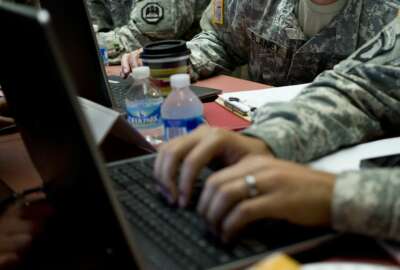
New Army Reserve chief asks whether reservists are stationed in right places
The Army Reserve’s new leader says it’s time for a fresh look at the map so that his component of the Army can make the most of its ability to harness the...
To one degree or another, the Army Reserve already has a presence in all 50 states, five U.S. territories and more than two dozen foreign nations. But the Reserve’s new leader says it’s time for a fresh look at the map so that his component of the Army can make the most of its ability to harness the skills its citizen-soldiers get from their civilian jobs.

Lt. Gen. Charles Luckey, sworn-in four months ago as the Reserve’s newest chief, said he’s about to begin a geographic and demographic analysis of the current home stations at which more than 200,000 uniformed and civilian personnel work and spend their drill time, asking whether they’re appropriately postured to recruit and retain people with the skills that are vital to the specialized “enabling” capabilities that make up most of the Reserve.
“Cyber is a good example of this, and a domain in which I have interest,” Luckey said in an interview for Federal News Radio’s On DoD. “Just as a practical matter — given that most of my soldiers would like to live relatively proximate to where both their civilian job and their Army Reserve job is, where should I be putting cyber force structure so I can both capture talent and make it palatable to stay in the Army?”
The Army Reserve has been tasked with building 10 of its own cyber protection teams on top of the 133 DoD is already building from mostly active duty service members. To accomplish that, one school of thought would suggest placing large numbers of cyber reservists near locations like Fort Meade, Maryland, the headquarters of U.S. Cyber Command, or Fort Gordon, Georgia, an NSA outpost that’s soon to become the home base for Army Cyber Command, so that they can work regularly with their active component counterparts.
Luckey said he’s leaning toward a different model that would relocate reserve units so that they’re physically near large concentrations of civilian sector technology employers. That’s partially because many of the active-duty soldiers who make up the Army’s current crop of active-duty cyber teams are almost certain to depart for higher-paying private sector jobs at some point, and the Army would like to retain the training it’s invested in those soldiers.
“I probably want my cyber forces to be in the places where soldiers are going to go when they make a decision to leave the active component,” he said. “They’re going to leave Fort Gordon, and I want to get a sense of where they’re likely to go. On the other side, I need to map out where the civilian skills we want are more likely to be resident so that I’m matching our future force structure to likely good bets where we can take advantage of that talent.”
The fresh look at reserve force stationing and talent management was one of three main focus areas the new Reserve chief said he planned to pursue during a wide-ranging 40-minute radio interview.
The others:
Building and maintaining the readiness of Army Reserve forces
“It’s job one,” Luckey said. “At the individual level, I have to have soldiers who are prepared in terms of their skills, their training, their equipment, their education, their medical readiness, and be able to aggregate that into units that are able to deploy into a theater of operations on relatively short notice. Those operations are probably going to be more contested and more dynamic than what we’ve seen in the last 15-20 years. … The Army is going to expect me to deliver capabilities to those environments within 35 to 40 days. I need to understand what those forces are going to look like and how much time I have to get that force ready enough that it would be morally conscionable to send it into a contested theater of operations. Once I’ve identified the numbers of soldiers and units, we’ll prioritize to make sure a certain percentage of the Army Reserve is ready for a near-term challenge.”
Maintaining support from civilian employers and families
“This is important for all the services and all the components, but the additional challenge for the Army Reserve is the geographic dispersion of our forces,” he said. “At the end of the day, we have to be ready enough to be relevant to meet the needs of the Army and the joint warfighter, but also not train so hard and so often that my soldiers can’t keep a good, upwardly mobile civilian occupation. We don’t want to put people in a position that they have to choose between continuing to serve and moving exclusively into the civilian sector.”
Copyright © 2025 Federal News Network. All rights reserved. This website is not intended for users located within the European Economic Area.
Jared Serbu is deputy editor of Federal News Network and reports on the Defense Department’s contracting, legislative, workforce and IT issues.
Follow @jserbuWFED





